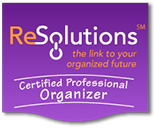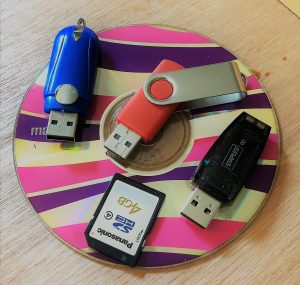Everyone uses external, or portable, media to store and transfer files easily. This type of media can include SD Cards, Flash, or USB, drives, and even, in some cases, old CDs, flash, or USB, drives to store and transfer files. USB drives are an easy, inexpensive way to store and move files. You can literally find these devices for sale at even the local drug store. Over time, the sheer number of SD Cards, USB Drives, and, yes, even those dinosaur CDs, can accumulate. This puts you at not only an organization risk, because you don’t know what data is on which media, but also a security risk should one of those drives get lost. Here’s how to organize your portable media so that the right data is readily available when you need it, and so that all of your information is safely protected.
- Do NOT Use a Portable as a Whole PC Backup.My first, and most important, piece of advice is that any data storage device you plan to use to transfer or share data should NOT be used to back up your computer. A back up of your primary PC is bound to include sensitive data such as account numbers, passwords, financial data, and even proprietary work files. Definitely back up your PC to external media. Place that media in a secure place in your home and leave it there. Alternately, use a secure account on the Cloud.
- Gather Them Up.Start by going through your purse, your desk, your brief cases, and the places you typically keep media storage devices including those storage crates in the attic. Choose a single place to put all of your storage devices and put them there. A clearly labeled plastic container, makeup bag from a “bonus”, or shoebox works well for this purpose. As you go through the house during your daily routine and find storage devices add them to the pile.
- Find Out What’s On Them.The best way to start organizing all of the files on your portable storage devices is to see what it on them! This may be a tedious job but how else will you know if there is anything worth keeping on the drive? Make time to insert each USB Drive, SD Card, or CD into a computer and see what files/folders are stored on it. Delete any files you no longer need from the drive immediately.
- Put It All In a Single Place.Set up a folder on your computer or laptop called “USB Data”. As you go through each USB, CD, or SD Card copy the information you want to keep into this folder in a separate folder, such as “USB 1”, “USB 2” etc. This will put all of your data in the same place, but avoid overwriting files on different devices with the same file name until you can be sure they are not duplicate files.
- Check for Duplicates.Once you have all of the data from those external drives in once place, compare those files with each other and to what you currently have on your computer. Delete any duplicates and anything already backed up to your primary computer backup.
- Use the Cloud.If you are using external portable media to store files that need to go between multiple computers, consider a cloud-based service, such as DropBox, Google Drive, or Microsoft OneDrive. A list of highly rated cloud storage services can be found on PCMag.com by clicking here. Having only one version of a file floating around will cause less confusion.
- Wipe It.Dispose of any external media you for whatever reason do not want to keep by wiping the drive. If you plan to throw the physical drive away, consult with an IT professional for ways to permanently remove the data from it before you do. CDs can be broken into pieces and thrown away or if you have a shredder that can shred CDs, all the better.
- Mark It Up.If you want to also keep the storage device, you will need a way to identify the info. Although flash drives are small you need to label them. One way is to use a label maker and adhere the label to the drive. Some of the flash drives have a loop that you could also attach a label on a piece of paper and punch a hole in the label and tie a string or twisty tie and slip it through the loop. A black Sharpie Magic Marker also works great for marking CDs, USBs, and SD Cards.
- Dedicate Space.Whenever you need to keep external drives, please make sure you have one dedicated spot to contain all of them, so you aren’t constantly running across them and more importantly, not knowing where the one you need is located.
The long winter months ahead are a great time to gather all of your external devices and sort them. This is a great activity for when you are streaming a movie on your PC or sitting with your laptop watching a movie you’re not quite into. Knowing where all of your data is will give you piece of mind, and having all those small, pesky storage drives in a single place will give you piece of mind.
Photo: Cristina M. Miller

 Join My Email List
Join My Email List

Leave a Reply
You must be logged in to post a comment.